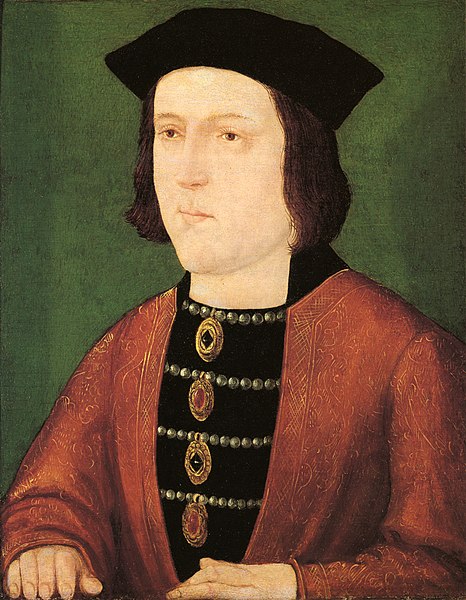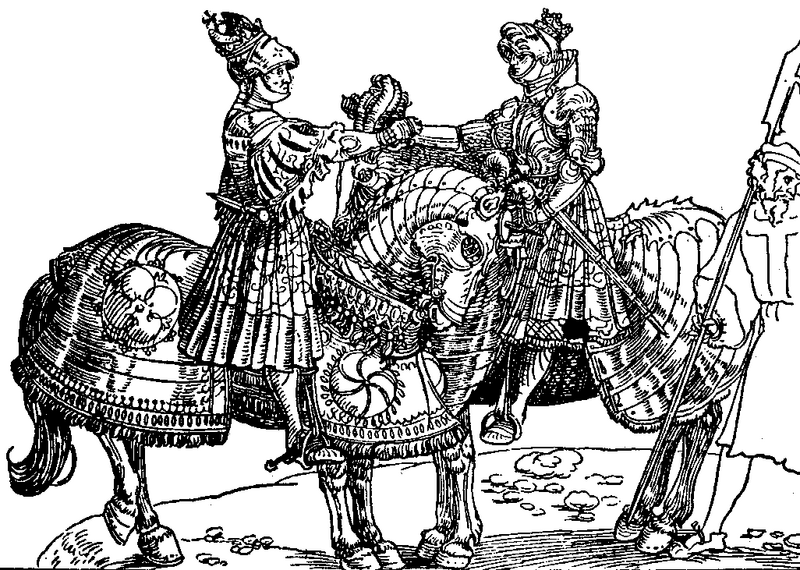 |
| Edward IV |
An Illegitimate Birth
Arthur
Plantagenet was the illegitimate son of Edward IV and his mother was probably Elizabeth Lucy, daughter of one Thomas Wayte, a Hampshire gentleman. The
date of Arthur’s birth is similarly lost in time, but believed to be between
1461 and 1475. 1462 is more probable as Edward possibly met and seduced
Elizabeth Lucy, a widow, on a summer progress in 1461.
Edward’s
mother, the dowager Duchess of York, was furious when Edward married the
portionless Elizabeth Woodville in May 1464. The duchess claimed
that Edward’s marriage was invalid as Edward had promised to marry Elizabeth
Lucy. Thomas More claimed in his History of King Richard III[i]
that, the seemingly naïve, Elizabeth Lucy under examination agreed that Edward
had never promised to marry her;
‘She said his grace [Edward
IV} spoke so loving words unto her that she verily hoped he would have married
her, and if it had not been for such kind words she would never have showed
such kindness to him to let him so kindly get her with child.’[ii]
Written
sometime after the event and more with an eye to drama than accuracy, the
history traduces the author’s patron’s predecessors. Sir George Buck claimed
that Edward;
‘Loved her well and she was
his witty concubine, for she was a wanton wench, and willing and ready to yield
herself to the king and to his pleasures without any conditions.’[iii]
Arthur’s
birthplace was Calais, the last bastion of Plantagenet
holdings in France[iv].
Now all that was left was the Pale of circa 120 square miles surrounding the town and including
the fort of Guisnes. Arthur was originally known as
Arthur Wayte. It is highly possible that Elizabeth was also the mother of
Elizabeth Plantagenet, born in 1464, which would imply that she had become the
king’s mistress.
Arthur at Court
 |
| Elizabeth of York |
Arthur’s
godfather was William FitzAlan, 16th Earl of Arundel. Arthur spent his childhood at the
Edward’s court. At the age of ten he moved to join his mother’s family at one
of their manors; Byrne tentatively identifies the manor as that of Soberton in Hampshire. In 1472 the king’s tailor was ordered to make Arthur
several robes. When Edward died in 1483 the 23 year old Arthur disappeared from
the record for 17 years.
Having
usurped the throne from Richard III[v] in August 1485, Henry VII married Arthur’s legitimate sister Elizabeth. In 1501 Arthur reappeared joining his half-sister
Elizabeth’s household. When Elizabeth died in 1503 Arthur then became part of
his brother-in-law’s household. Henry was indulgent to his brother-in-law.
Arthur’s
relationship with the royal family was acknowledged and the de la Poles from
the Countess of Salisbury down greeted him as cousin. In turn
Arthur habitually referred to Cardinal de la Pole as ‘my cousin Reynold
Pole.’ Arthur took after his father in that he was easy going and
agreeable. He also continued the family trait in that he was a veritable giant
of a man, being over 6’3”[vi]. Thomas More described
Arthur as;
‘Princely to behold, of
visage lovely, of body mighty, strong and clean made.’[vii]
When
Arthur’s nephew Henry succeeded to the throne Arthur was made an Esquire of the
King's Bodyguard and was a Gentleman of the Privy Chamber. He was a close companion of Henry's
despite the disparity in ages. Arthur was also appointed the King’s Carver,
although the date of the appointment is not known.
Marriage Number One
 |
| Edward Dudley (R), Henry VII (C) |
On 12th November
1511 Arthur was married to Elizabeth
Grey, daughter of Edward Grey, 1st Viscount Lisle. She was the widow of Edmund Dudley,
treasurer to King Henry VII, who had been executed the previous year on charges
of treason. The day after the wedding the king granted Arthur some of the
Dudley estates which had reverted to the crown as a result of Dudley's
attainder.
Elizabeth had three sons by
her previous marriage; Arthur’s eldest stepchild was John Dudley[viii]. The year after the wedding John was made the ward of
Sir Edward Guildford and was taken into his household. Elizabeth’s second son
Andrew was placed in the household of
the Duke of Norfolk. Arthur seems to have
taken no interest in either Andrew or Jerome, Elizabeth’s youngest son. Jerome
apparently was mentally or physically disabled and, although destined for the
priesthood, was unable to take orders.
Arthur and Elizabeth had
three daughters: Frances[ix], Elizabeth[x] and Bridget who was placed
in the care of Dame Elizabeth Shelley, Abbess of St Mary’s Abbey in Winchester .
Disaster
at Sea
 |
| Louis XII |
In 1512 Arthur was made a
member for the Commission of the Peace[xi] for Hampshire and he remained so for many years. The
following year Arthur was made a Spear of Honour, a crack corps of men of noble
blood.
Eager to prove his martial
prowess, and bound by a treaty of 5th April 1513[xii], Henry’s troops invaded
France while Louis XII’s
troops were involved elsewhere in a fruitless attempt to regain his maternal inheritance in Italy[xiii]. Arthur held a command
in the navy and was responsible for the seas between the Thames estuary and Brest.
The fleet under the command
of Sir Edward Howard[xiv], Lord High Admiral, took to the waters on 20th April; it suffered from a lack
of victuals due to the speed of the orders from Henry. Arriving in Brest,
Howard found the weather inclement, the town and harbour heavily defended by
Admiral Prégent de Bidoux. The English ships were unsuited to close infighting
in the harbour.
Howard, pressured by a
letter from Henry, made an attempt to attack the French galleys[xv]. Howard managed to board
Prégent’s galley but Howard was driven overboard and drowned, dragged down by
the weight of his own armour. The dispirited fleet returned to Plymouth on 30th
April to regroup under the new Lord High Admiral, Edward’s elder brother Thomas, Earl of Surrey[xvi] who wrote to Henry that the sailors;
‘Had as leve go in to Purgatory as to the
trade [of battle]’[xvii]
Henry’s scathing letters of
rebuke to the captains had only made things worse. Howard requested permission
to launch raids into Brittany. Henry was only too happy to authorise this as it
gave cover for the land invasion due in short measure.
Victory
on Land
 |
| Maximilian (L) and Henry VIII (R) meet at Therouanne |
The English troops in
conjunction with the troops of Maximilian I[xviii], the Holy Roman Emperor besieged Thérouanne, and
defeated the French led by La Palice at
the Battle of the
Spurs on 16th August; the Imperial
Master of the Posts wrote;
‘Early in the day the
Emperor and the King of England encountered 8,000 French horse; the Emperor,
with 2,000 only, kept them at bay until four in the afternoon, when they were
put to flight.’[xix]
The allies then went on to
capture Tournai; the
two towns were all the booty that Henry was to receive as a result of his
efforts.
In an attempt to divert
English involvement in France James IV of
Scotland[xx] invaded England at Louis’ behest. The Scots failed to
draw Henry's attention from France, and James’ death and the Scots'
catastrophic defeat at the Battle of Flodden on 9th September did nothing to assist the Scottish cause.
Bibliography
Richard
III’s ‘Beloved Cousyn’ – John Ashdown-Hill, The History Press 2015
The Lisle
Letters – Muriel St Clare Byrne, Penguin Books 1985
Cardinal
Wolsey – Mandell Creighton, MacMillan & Co 1891
The Royal
Bastards of Medieval England – Chris Given-Wilson and Alice Curteis, Barnes and
Noble Inc. 1984
Elizabeth
and Leicester – Sarah Gristwood, Bantam Press 2008
The Ebbs and
Flows of Fortune – David M Head, University of Georgia Press 2009
Thomas
Cromwell – Robert Hutchinson, Phoenix 2008
The Earlier
Tudors – JD Mackie, Oxford University Press 1992
Thomas More
– Richard Marius, Weidenfeld & Nicholson 1993
The Tudor
Navy – Arthur Nelson, Conway Maritime Press 2001
Illustrated
Letters of the Paston Family – Robert Virgoe (Ed), MacMillan London Ltd 1989
www.en.wikipedia
[i]
Although More did not finish his history and it was not printed at the time.
Published after More’s death the history is believed to have influenced Shakespeare when
he wrote his Richard
III
[ii]
Thomas More – Marius
[iii]
The Royal Bastards of Medieval England – Given-Wilson & Curties
[iv]
Originally captured by Edward III in
1347, Calais was retaken by the French in 1558. All wool exported to the
continent from England had to be exported through Calais and the Staple was the largest
single producer of royal revenue.
[vi]
When his coffin was opened in 1788 his skeleton measured 6’3.5”
[vii]
The Lisle Letters - Byrne
[viii]
Later the Duke
of Northumberland Dudley died on the
scaffold when his attempt to place his niece Lady Jane Grey on the
throne failed. Dudley was unlikely to have had much contact with Arthur as he
was made a ward of Sir
Edward Guilford when he was 7. He later married Guildford’s daughter Jane
[ix]
Frances was married twice: firstly
to her step-brother John Basset (1520–1541) of Umberleigh, Devon, the son of Arthur's second wife by her
first marriage. When he died she married Thomas Monke of Potheridge, Devon, of an ancient Devonshire family. Her
great-grandson by this marriage was George Monck, 1st Duke of Albemarle (1608–1670)
[x]
She married Sir Francis Jobson,
Member of Parliament for Colchester; he was also a Receiver in the Court of
Augmentations. A proposed marriage to the eldest son of Sir Francis Lovell fell
through
[xi]
Now known as Justices for the Peace or JP or Magistrates
[xii]
The treaty bound Henry invade France
within 30 days; the co-signatories were the Holy Roman Emperor, the Pope Julius II and Ferdinand of Aragon
[xiii]
A small part of the War of the League of Cambrai
[xv]
Brought round from the Mediterranean
[xvii]
The Ebbs and Flows of Fortune - Head
[xviii]
By this time Ferdinand had come to an agreement with Louis XII and left his
son-in-law in the lurch
[xx]
A traditional ally of France against the English
presumably it was yet another woman [since I'm afraid I've forgotten the name] that Edward IV went through a form of wedding ceremony with which enabled Richard III to claim his marriage to Woodville as bigamous and the princes as illegitimate; or else Arthur would have been the heir. But then, by all accounts, Edward got about rather and was a bit of a slut.
ReplyDelete